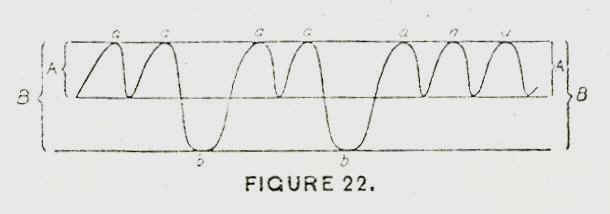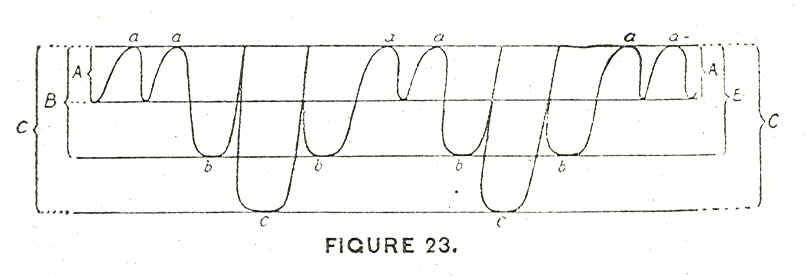
Home Boris Sidis Archives Table of Contents Next Chapter
|
PSYCHOPATHOLOGICAL
RESEARCHES Boris Sidis, M. A., Ph.D.,
M.D. © 1908
|
CHAPTER IV
THE PSYCHOGENETIC LAW
THESE alternating personalities, however, were but ephemeral; the process of regular alternation was but of brief duration. At first the patient had to pass through the exaltant stage in order to reach the level of the second trance personality; soon the first trance personality was observed to shrink in its dimensions and duration and finally disappeared altogether, the patient passing from the melancholic waking state directly into the state of the second trance personality. This first trance personality never reappeared; its constituent elements seemed to have become dissolved and fused with the second subconscious personality. As a matter of fact one could clearly observe that the mood of the second subconscious personality became far more cheerful and had lost somewhat of its pristine gravity and sedate contentment.
This dropping out of the first subconscious personality was already observed in the reverse process of ascent from the deeper levels of the subconscious back to the upper levels of waking life. In coming out of the deeper states of subconsciousness from the strata of the second personality formation, the patient returned directly to the waking state without first passing through the intermediary levels of the first subconscious personality. With the repetition of the series in its downward and upward course, this intermediary first-personality stage became shortened, shrank more and more, and finally was blended and fused in a condensed form with the last phase of the process, with the second subconscious personality.
The patient's states and the cycles with the stages through which he passed may be graphically represented by the following diagrams:

Let A,A (Figure 21) represent the content of the stream of the melancholic waking consciousness; the waves a,a represent mental states of the upper stream. Although the waves and the states they designate are not the same, still for the sake of clearness and precision they are termed the a,a waves and the designated states the a,a states.

In Figure 22, B,B represent the subconscious content of the first trance stratum and the waves b,b some of its mental states. The waves are termed the b,b waves and the designated states the b,b states.

In Figure 23, C,C represent the subconscious stratum in which the second trance personality has become developed, the mental states of which are represented by the waves c,c. The waves of the second trance personality belonging to the last stratum are termed the c,c waves and the designated' states the c,c states.
The patient, in passing from the waking state through the strata of the first and second trance personalities, then from the second trance personality through the first trance personality back to the waking state, passes through a cycle which may be termed the psychopathic cycle. This cycle is indicated by its corresponding curve which may be termed the psychopathic curve.
The relations of memory content of the various mental states are indicated by the areas, or better to say by the volume, of the waves; thus the wave b possesses its own content and reproduces that of the waking state A, A. The wave falls short of the stratum C,C, and cannot reproduce the content of the second trance personality. The c,c waves of the stratum C,C possess their own content and reproduce the content of the waking and first trance states belonging to the strata A,A and B,B. The a,a waves of the waking stratum reproduce partially and imperfectly the content of the b,b waves, the power of reproduction failing with the progress of the psychopathic process and the frequent repetition of the cycles. The a,a waves are completely cut off from all access to the e,e waves with their special content coming from the subconscious stratum B,B.
The psychopathological process regarded as a whole passed through five stages which, though imperceptibly merging one into the other, were still distinctly marked.
In the first stage, the a,a waves of the stratum A,A, representing the upper consciousness, were alone functioning. Only the melancholic states, the a,a states, were present (Figure 21).
In the second stage, the b,b waves representing the b,b states of the stratum of the first trance personality were brought into active function, forming a cycle aba (Figure 22).
In the third stage, the c,c waves and c,c states of the stratum of the second trance personality began to function, giving rise to the cycles abcba (Figure 23).
The patient had to pass through the b,b states in order to enter the c,c states of the second trance personality, and on emerging from the c,c states the b,b states were passed through again before the a,a states of the upper waking consciousness could be reached.
In the fourth stage, the patient reached the c,c states through the b,b states, but on emerging from the c,c states the b,b states were omitted, the patient rising directly to the a,a states, the cycle becoming abbreviated to abca (Figure 24).

In the fifth stage, the b,b states were altogether eliminated, the patient passing directly from the a,a states into the c,c states, and then back again into the a,a states, the cycle becoming reduced to am (Figure 25).

The process of abbreviation in this case is the general course usually taken by series of subconscious personalities. In a condensation of a series of subconsciously formed personalities, the tendency is towards condensation. The intermediary links are dropped or suppressed in most of the detail traits and are incorporated with the last members of the series, which become more prominent in proportion to the frequency of repetition of the series as a whole.
The last members of the series grow and develop by the process of assimilation of the intermediary links. The tendency, in short, is toward omission of the intermediary personalities and toward survival of the lastly organized personalities. Such personalities may become stable and form the guiding, controlling personages of the dramatic interplay characteristic of the highly developed subconscious life activity.
This process of elimination is no doubt of the same order as that found to be characteristic of psychic activities in general. In the compounds of sensory elements, both primary and secondary, in the fusion of feelings, and in the flow of association of representations and ideas we meet with a tendency toward condensation, toward abbreviation of intermediary links, toward formation of "short cuts," so to say.
Thus the memory process is really an abbreviation of the past experiences. In reviewing the past, a good many of the details are suppressed; only the general outlines, with the most important and essential features of outlived experiences are preserved. A life of years is reviewed in a mental glance of a few moments.
Were it not for this process of abbreviation, for this dropping out and elimination of most of the details and preservation of the most general essential outlines embodied in the last act of recollection, it would require a lifetime to recall our life experiences. Memory would be a burden. Only on condition of suppression, of elimination, of abbreviation of most of the details in past series, only on condition of forgetfulness, can mental life grow and develop. Memory foreshortens the past; it looks at what has gone by through the other end of the telescope, so to say. In this respect, the process of recollection closely resembles that of conception, which is highly symbolic representative summary of past sensations, perceptions, and representations. Memory is a symbolic epitome of the past.
Something parallel we find in biological series where the formation of a species is brought about by extinction, the extermination of the intermediary varieties and by the survival of the last links of the series, which in a condensed form represent the main traits of the so-called "missing links." The process of evolution of species and genera is one great illustration of this process of elimination of intermediary links. In the evolution of the individual, we meet once more with a similar process of condensation, inasmuch as the development of the particular organism presents a condensed and abbreviated history of the stages passed through by its ancestors in the long course of organic evolution; or, as it is often expressed in the well-known biogenetic law, that ontogeny is an abbreviation or an epitome of phylogeny.
Evolutionary series seem to be conditioned on this process of elimination and condensation of intermediary links; it is economy of time and energy and makes possible further development. The biogenetic law holds good of all biological and psychological evolutionary processes. However the case may be, the fact remains that the first trance personality was suppressed and entirely disappeared, the patient passing from the waking state directly into the condition of the second trance personality, a fact characteristic of all intermediary subconscious personalities,―their fate being to come and vanish from the scene of life, without ever gaining a firm hold on the life-existence of the individual.